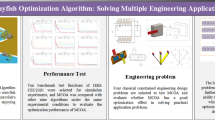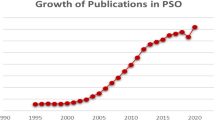Abstract
A Hyperspectral image (HSI) contains numerous spectral bands, providing better differentiation of ground objects. Although the data from HSI are very rich in information, their processing presents some difficulties in terms of computational effort and reduction of information redundancy. These difficulties stem mainly from the fact that the HSI consists of a large number of bands along with some redundant bands. Band selection (BS) is used to select a subset of bands to reduce processing costs and eliminate spectral redundancy. BS methods based on a metaheuristic approach have become popular in recent years. However, most BS methods based on a metaheuristic approach can get stuck in the local optimum and converge slowly due to a lack of balance between exploration and exploitation. In this paper, three BS methods are proposed for HSI data. The first method applies Crow Search Algorithm (CSA) for BS. The other two proposed methods, HPSOCSA_SP and HPSOCSA_SLP, are based on the hybridization of Particle Swarm Optimization (PSO) and CSA. The purpose of these hybridizations is to balance exploration and exploitation in a search process for optimal band selection and fast convergence. In hybridization techniques, PSO and CSA exchange informative data at each iteration. HPSOCSA_SP split the population into two equal parts. PSO is applied to one part and CSA to the other. HPSOCSA_SLP selects half of the top-performing members based on fitness. PSO and CSA are applied to the selected population sequentially. Our proposed models underwent rigorous testing on four HSI datasets and showed superiority over other metaheuristic techniques.














Similar content being viewed by others
Data availability
The data (outputs) generated or analyzed during this study are included in this manuscript.
References
Sun W, Du Q (2019) Hyperspectral band selection: a review. IEEE Geosci Remote Sens Mag 7(2):118–139. https://doi.org/10.1109/MGRS.2019.2911100
Gao H, Lin S, Li C, Yang Y (2019) Application of hyperspectral image classification based on overlap pooling. Neural Process Lett 49(3):1335–1354. https://doi.org/10.1007/s11063-018-9876-7
Zhang W, Li X, Zhao L (2018) A fast hyperspectral feature selection method based on band correlation analysis. IEEE Geosci Remote Sens Lett 15(11):1750–1754. https://doi.org/10.1109/LGRS.2018.2853805
Salimi A, Ziaii M, Amiri A, Hosseinjani M, Karimpouli S, Moradkhani M (2018) Using a feature subset selection method and support vector machine to address curse of dimensionality and redundancy in Hyperion hyperspectral data classification. Egypt J Remote Sens Sp Sci 21(1):27–36. https://doi.org/10.1016/j.ejrs.2017.02.003
Yan Y, Yu W, Zhang L (2022) A method of band selection of remote sensing image based on clustering and intra-class index. Multimed Tools Appl 81:22111–22128. https://doi.org/10.1007/s11042-021-11865-1
Groves P, Bajcsy P (2004) Methodology for hyperspectral band and classification model selection. 2003 IEEE Work Adv Tech Anal Remote Sensed Data, vol. 00, no. C, pp 120–128. https://doi.org/10.1109/WARSD.2003.1295183
Patro RN, Subudhi S, Biswal PK, Dell’acqua F (2021) A review of unsupervised band selection techniques. IEEE Geosci Remote Sens Mag 9(3):72–111. https://doi.org/10.1109/MGRS.2021.3051979
Licciardi G, Marpu PR, Chanussot J, Benediktsson JA (2012) Linear versus nonlinear PCA for the classification of hyperspectral data based on the extended morphological profiles. IEEE Geosci Remote Sens Lett 9(3):447–451. https://doi.org/10.1109/LGRS.2011.2172185
Villa A, Benediktsson JA, Chanussot J, Jutten C (2011) Hyperspectral image classification with independent component discriminant analysis. IEEE Trans Geosci Remote Sens 49(12 PART 1):4865–4876. https://doi.org/10.1109/TGRS.2011.2153861
Gao P, Wang J, Zhang H, Li Z (2019) Boltzmann entropy-based unsupervised band selection for hyperspectral image classification. IEEE Geosci Remote Sens Lett 16(3):462–466. https://doi.org/10.1109/LGRS.2018.2872358
Li S, Wu H, Wan D, Zhu J (2011) An effective feature selection method for hyperspectral image classification based on genetic algorithm and support vector machine. Knowl-Based Syst 24(1):40–48. https://doi.org/10.1016/j.knosys.2010.07.003
Kohavi R, John GH (1997) Wrappers for feature subset selection. Artif Intell 97(1–2):273–324. https://doi.org/10.1016/s0004-3702(97)00043-x
Paul A, Chaki N (2021) Dimensionality reduction of hyperspectral image using signal entropy and spatial information in genetic algorithm with discrete wavelet transformation. Evol Intell 14:1793–1802. https://doi.org/10.1007/s12065-020-00460-2
Wang M, Wu C, Wang L, Xiang D, Huang X (2019) A feature selection approach for hyperspectral image based on modified ant lion optimizer. Knowl-Based Syst 168:39–48. https://doi.org/10.1016/j.knosys.2018.12.031
Archibald R, Fann G (2007) Feature selection and classification of hyperspectral images with support vector machines. IEEE Geosci Remote Sens Lett 4(4):674–677. https://doi.org/10.1109/LGRS.2007.905116
Chaudhuri A, Sahu TP (2021) Feature selection using binary crow search algorithm with time varying flight length. Expert Syst Appl, vol. 168, https://doi.org/10.1016/j.eswa.2020.114288
Rashedi E, Rashedi E, Nezamabadi-pour H (2018) A comprehensive survey on gravitational search algorithm. Swarm Evol Comput 41(January):141–158. https://doi.org/10.1016/j.swevo.2018.02.018
Yang H, Du Q, Chen G (2012) Particle swarm optimization-based hyperspectral dimensionality reduction for urban land cover classification. IEEE J Sel Top Appl Earth Obs Remote Sens 5(2):544–554. https://doi.org/10.1109/JSTARS.2012.2185822
Medjahed SA, Ait Saadi T, Benyettou A, Ouali M (2016) Gray wolf optimizer for hyperspectral band selection. Appl Soft Comput J 40:178–186. https://doi.org/10.1016/j.asoc.2015.09.045
Xie F, Li F, Lei C, Yang J, Zhang Y (2019) Unsupervised band selection based on artificial bee colony algorithm for hyperspectral image classification. Appl Soft Comput J 75:428–440. https://doi.org/10.1016/j.asoc.2018.11.014
Sawant SS, Manoharan P (2019) New framework for hyperspectral band selection using modified wind-driven optimization algorithm. Int J Remote Sens 40(20):7852–7873. https://doi.org/10.1080/01431161.2019.1607609
Phaneendra Kumar BLN, Manoharan P (2021) Whale optimization-based band selection technique for hyperspectral image classification. Int J Remote Sens 42(13):5109–5147. https://doi.org/10.1080/01431161.2021.1906979
Ghosh A, Datta A, Ghosh S (2013) Self-adaptive differential evolution for feature selection in hyperspectral image data. Appl Soft Comput J 13:1969–1977. https://doi.org/10.1016/j.asoc.2012.11.042
Su H, Du Q, Chen G, Du P (2014) Optimized hyperspectral band selection using particle swarm optimization. IEEE J Sel Top Appl Earth Obs Remote Sens 7(6):2659–2670. https://doi.org/10.1109/JSTARS.2014.2312539
Xu Y, Du Q, Younan NH (2017) Particle swarm optimization-based band selection for hyperspectral target detection. IIEEE Geosci Remote Sens Lett 14(4):554–558. https://doi.org/10.1109/LGRS.2017.2658666
Ghamisi P, Benediktsson JA (2015) Feature selection based on hybridization of genetic algorithm and particle swarm optimization. IEEE Geosci Remote Sens Lett 12(2):309–313. https://doi.org/10.1109/LGRS.2014.2337320
Aghaee R, Momeni M, Moallem P (2022) Semisupervised band selection from hyperspectral images using levy flight-based genetic algorithm. IEEE Geosci Remote Sens Lett 19. https://doi.org/10.1109/LGRS.2022.3147272
Medjahed SA, Saadi TA, Benyettou A, Ouali M (2015) Binary cuckoo search algorithm for band selection in hyperspectral image classification. IAENG Int J Comput Sci 42(3):1–9
Sawant S, Manoharan P (2021) A hybrid optimization approach for hyperspectral band selection based on wind driven optimization and modified cuckoo search optimization. Multimed Tools Appl 80(2):1725–1748. https://doi.org/10.1007/s11042-020-09705-9
Wang M, Liu W, Chen M, Huang X, Han W (2021) A band selection approach based on a modified gray wolf optimizer and weight updating of bands for hyperspectral image. Appl Soft Comput, vol. 112, https://doi.org/10.1016/j.asoc.2021.107805
Tschannerl J et al (2019) MIMR-DGSA: unsupervised hyperspectral band selection based on information theory and a modified discrete gravitational search algorithm. Inf Fus 51:189–200. https://doi.org/10.1016/j.inffus.2019.02.005
Ding X et al (2020) An improved ant Colony algorithm for optimized band selection of hyperspectral remotely sensed imagery. IEEE Access 8:25789–25799. https://doi.org/10.1109/ACCESS.2020.2971327
Anand R, Samiaappan S, Veni S, Worch E, Zhou M (2022) Airborne Hyperspectral Imagery for Band Selection Using Moth–Flame Metaheuristic Optimization. J Imaging, vol. 8, no. 5, https://doi.org/10.3390/jimaging8050126
Wang M, Yan Z, Luo J, Ye Z, He P (2021) A band selection approach based on wavelet support vector machine ensemble model and membrane whale optimization algorithm for hyperspectral image. Appl Intell 51(11):7766–7780. https://doi.org/10.1007/s10489-021-02270-0
Eberhart R, Kennedy J (1995) A new optimizer using particle swarm theory. MHS’95. Proc. sixth Int. Symp. Micro Mach. Hum. Sci. Nagoya, Japan, pp 39–43, https://doi.org/10.1109/MHS.1995.494215
Samee NA et al (2022) Metaheuristic optimization through deep learning classification of COVID-19 in chest x-ray images. Comput Mater Contin 73(2):4193–4210. https://doi.org/10.32604/cmc.2022.031147
Hamadache I, Mellal MA (2021) Design optimization of a car side safety system by particle swarm optimization and grey wolf optimizer. In: Nature-Inspired Computing Paradigms in Systems. Academic Press, Elsevier Inc., pp 15–24. https://doi.org/10.1016/B978-0-12-823749-6.00006-4
Yang X-S, Chien SF, Ting TO (2015) Bio-inspired computation and optimization: an overview. Bio-inspired computation in telecommunications, pp 1–21. https://doi.org/10.1016/B978-0-12-801538-4.00001-X
Askarzadeh A (2016) A novel metaheuristic method for solving constrained engineering optimization problems: crow search algorithm. Comput Struct 169:1–12. https://doi.org/10.1016/j.compstruc.2016.03.001
Adamu A, Abdullahi M, Junaidu SB, Hassan IH (2021) An hybrid particle swarm optimization with crow search algorithm for feature selection. Mach Learn Appl 6:100108. https://doi.org/10.1016/j.mlwa.2021.100108
Hassan E, Shams MY, Hikal NA, Elmougy S (2023) The effect of choosing optimizer algorithms to improve computer vision tasks: a comparative study. Multimed Tools Appl 82(11):16591–16633. https://doi.org/10.1007/s11042-022-13820-0
Li Y, Zhang H, Xue X, Jiang Y, Shen Q (2018) Deep learning for remote sensing image classification: A survey. Wiley Interdiscip Rev Data Min Knowl Discov 8(6):1–17. https://doi.org/10.1002/widm.1264
Gamel SA, Hassan E, El-Rashidy N, Talaat FM (2023) Exploring the effects of pandemics on transportation through correlations and deep learning techniques. Multimed Tools Appl, no. 0123456789, https://doi.org/10.1007/s11042-023-15803-1
Hssayni EH, Joudar NE, Ettaouil M (2022) An adaptive drop method for deep neural networks regularization: estimation of DropConnect hyperparameter using generalization gap. Knowl-Based Syst, vol. 253, https://doi.org/10.1016/j.knosys.2022.109567
Hssayni EH, Joudar N-E, Ettaouil M (2022) A deep learning framework for time series classification using normal cloud representation and convolutional neural network optimization. Comput Intell, vol. 38, https://doi.org/10.1111/coin.12556
Wang C, Ma N, Ming Y, Wang Q, Xia J (2019) Classification of hyperspectral imagery with a 3D convolutional neural network and J-M distance. Adv Sp Res 64(4):886–899. https://doi.org/10.1016/j.asr.2019.05.005
Hssayni EH, Joudar NE, Ettaouil M (2022) Localization and reduction of redundancy in CNN using L 1-sparsity induction. J Ambient Intell Humaniz Comput, https://doi.org/10.1007/s12652-022-04025-2
Author information
Authors and Affiliations
Corresponding author
Ethics declarations
Conflict of interest
The authors declare that they have no known competing financial or personal relationships that could be viewed as influencing the work reported in this paper.
Ethics approval
This article does not contain any studies with human participants or animals performed by any of the authors.
Additional information
Publisher’s note
Springer Nature remains neutral with regard to jurisdictional claims in published maps and institutional affiliations.
Rights and permissions
Springer Nature or its licensor (e.g. a society or other partner) holds exclusive rights to this article under a publishing agreement with the author(s) or other rightsholder(s); author self-archiving of the accepted manuscript version of this article is solely governed by the terms of such publishing agreement and applicable law.
About this article
Cite this article
Giri, R.N., Janghel, R.R. & Pandey, S.K. Band selection using hybridization of particle swarm optimization and crow search algorithm for hyperspectral data classification. Multimed Tools Appl 83, 26901–26927 (2024). https://doi.org/10.1007/s11042-023-16638-6
Received:
Revised:
Accepted:
Published:
Issue Date:
DOI: https://doi.org/10.1007/s11042-023-16638-6




